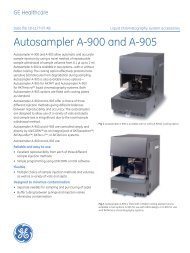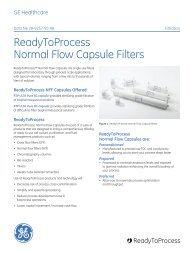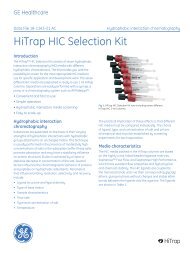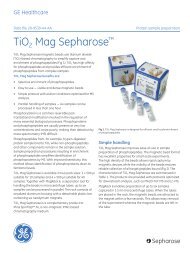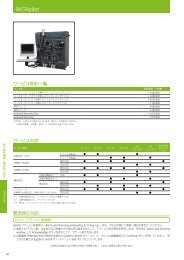[PDF] Ni Sepharose 6 Fast Flow
[PDF] Ni Sepharose 6 Fast Flow
[PDF] Ni Sepharose 6 Fast Flow
Create successful ePaper yourself
Turn your PDF publications into a flip-book with our unique Google optimized e-Paper software.
GE Healthcare<br />
Data file 11-0008-86 AE<br />
<strong>Ni</strong> <strong>Sepharose</strong> 6 <strong>Fast</strong> <strong>Flow</strong><br />
HisPrep FF 16/10<br />
HisTrap FF<br />
Affinity chromatography<br />
Purifying histidine-tagged recombinant proteins by immobilized<br />
metal affinity chromatography (IMAC) continues to grow in<br />
popularity. <strong>Ni</strong>ckel (<strong>Ni</strong> 2+ ) is the most commonly used metal ion<br />
in IMAC purifications.<br />
Key features include:<br />
• <strong>Fast</strong>, reliable scale-up of histidine-tagged protein purifications<br />
• High protein binding capacity, and minimal leakage of<br />
<strong>Ni</strong> 2+ ions<br />
• Compatible with a very wide range of reducing agents,<br />
detergents, and other additives<br />
• As BioProcess medium, <strong>Ni</strong> <strong>Sepharose</strong> 6 <strong>Fast</strong> <strong>Flow</strong><br />
meets industrial demands with security of supply and<br />
comprehensive regulatory support<br />
• Available as prepacked HisPrep and HisTrap columns<br />
for added speed, convenience and reproducibility<br />
• Suitable for gravity-flow purification using<br />
His GraviTrap columns, and multiwell plate screening<br />
using His MultiTrap plates<br />
IMAC <strong>Sepharose</strong> 6 <strong>Fast</strong> <strong>Flow</strong> is a related affinity medium,<br />
supplied free of metal ions, allowing the user to optimize<br />
selectivity by charging the medium with the most appropriate<br />
metal ion (see data file 28-4041-06 for more details).<br />
Chromatography medium characteristics<br />
<strong>Ni</strong> <strong>Sepharose</strong> 6 <strong>Fast</strong> <strong>Flow</strong> consists of 90 µm beads of highly<br />
cross-linked agarose, to which a chelating ligand has been<br />
immobilized. The chelating ligand is immobilized to the<br />
<strong>Sepharose</strong> 6 <strong>Fast</strong> <strong>Flow</strong> matrix at a density that, when<br />
charged with <strong>Ni</strong> 2+ ions, ensures a high binding capacity for<br />
proteins. Furthermore, leakage of <strong>Ni</strong> 2+ ions is minimized.<br />
Fig 1. <strong>Ni</strong> <strong>Sepharose</strong> 6 <strong>Fast</strong> <strong>Flow</strong> is available for all scales of work from<br />
convenient, prepacked HisTrap FF columns to bulk quantities.<br />
The medium is compatible with a wide range of additives<br />
commonly used in the purification of histidine-tagged proteins.<br />
Table 1 lists the main characteristics of <strong>Ni</strong> <strong>Sepharose</strong> 6<br />
<strong>Fast</strong> <strong>Flow</strong>. The medium is easy to work with and convenient<br />
to pack in a wide variety of columns from laboratory to<br />
production-scale.<br />
BioProcess media<br />
BioProcess media are developed and supported for productionscale<br />
chromatography. <strong>Ni</strong> <strong>Sepharose</strong> 6 <strong>Fast</strong> <strong>Flow</strong> is a BioProcess<br />
media and therefore fulfills essential criteria for validated<br />
production-scale manufacture, secure supply, scalability,<br />
and regulatory support. Regulatory Support Files (RSF) are<br />
available to assist process validation and submissions to<br />
regulatory authorities.
<strong>Ni</strong> <strong>Sepharose</strong> 6 <strong>Fast</strong> <strong>Flow</strong> is supplied preswollen in 5 ml, 25 ml,<br />
100 ml, 500 ml, 1 l and 5 l packs (Fig 1). The medium is easy<br />
to pack in a wide range of columns (Table 2). Full user<br />
instructions for packing, optimization, operation, cleaning,<br />
and recharging are supplied with each pack.<br />
Table 1. Main characteristics of <strong>Ni</strong> <strong>Sepharose</strong> 6 <strong>Fast</strong> <strong>Flow</strong><br />
Matrix<br />
Average particle size 90 µm<br />
Highly cross-linked 6% spherical<br />
agarose<br />
Dynamic binding capacity* Approx. 40 mg histidine-tagged<br />
protein/ml medium<br />
Metal ion capacity<br />
Approx. 15 µmol <strong>Ni</strong> 2+ /ml medium<br />
Max. linear flow rate † 600 cm/h (20 ml/min) using XK 16/20<br />
column with 5 cm bed height<br />
Recommended flow rate †<br />
Max. operating pressure †<br />
Compatibility during use<br />
Chemical stability ‡<br />
150 cm/h<br />
0.1 MPa, 1 bar (when packed in XK<br />
columns. May vary if used in other<br />
columns)<br />
Stable in all commonly used buffers,<br />
reducing agents, denaturants, and<br />
detergents, see Table 8.<br />
0.01 M HCl, 0.1 M NaOH.<br />
Tested for 1 week at 40°C.<br />
1 M NaOH, 70% acetic acid.<br />
Tested for 12 h.<br />
2% SDS. Tested for 1 h.<br />
30% 2-propanol. Tested for 30 min.<br />
pH stability ‡ Short term (at least 2 h): 2–14<br />
Long term (≤ 1 week): 3–12<br />
Storage<br />
* Dynamic binding capacity conditions:<br />
Sample:<br />
Column volume: 0.25 ml or 1 ml<br />
<strong>Flow</strong> rate:<br />
4°C to 30°C in 20% ethanol<br />
1 mg/ml (histidine) 6<br />
-tagged pure proteins (M r<br />
43 000) in binding buffer (capacity<br />
at 10% breakthrough) or (histidine) 6<br />
-tagged protein (M r<br />
28 000) bound from<br />
E. coli extract.<br />
0.25 ml/min or 1 ml/min, respectively<br />
Binding buffer: 20 mM sodium phosphate, 500 mM NaCl, 5 mM imidazole, pH 7.4<br />
Elution buffer: 20 mM sodium phosphate, 500 mM NaCl, 500 mM imidazole, pH 7.4<br />
Note: Dynamic binding capacity is protein-dependent.<br />
† H 2<br />
O at room temperature.<br />
‡ <strong>Ni</strong> 2+ -stripped medium.<br />
Prepacked columns<br />
<strong>Ni</strong> <strong>Sepharose</strong> 6 <strong>Fast</strong> <strong>Flow</strong> is available in the prepacked<br />
column formats HisPrep FF 16/10 and HisTrap FF.<br />
HisTrap FF and HisTrap FF crude columns<br />
HisTrap FF and HisTrap FF crude 1 ml and 5 ml prepacked<br />
columns offer reliable and convenient purification of histidinetagged<br />
recombinant proteins. The columns are simple to<br />
operate with a syringe and the supplied Luer adapter. The<br />
columns can also be used with a pump or chromatography<br />
system such as ÄKTA design systems. Note that ÄKTA design<br />
systems include preset method templates for HisTrap FF and<br />
HisTrap FF crude, which further enhances the simplicity of<br />
operation and reproducibility. In addition, multiple columns can<br />
be easily connected in series for increased purification capacity.<br />
Table 2. Recommended columns for <strong>Ni</strong> <strong>Sepharose</strong> 6 <strong>Fast</strong> <strong>Flow</strong> at different<br />
scales of operation<br />
Column Inner diam Bed volume Bed height<br />
(mm) (ml or l) max (cm)<br />
Laboratory-scale<br />
Tricorn 5/20 5 up to 0.55 ml 2.8<br />
Tricorn 5/50 5 up to 1.1 ml 5.8<br />
Tricorn 10/20 10 up to 2.2 ml 2.8<br />
Tricorn 10/50 10 up to 4.5 ml 5.8<br />
Tricorn 10/100 10 up to 8.5 ml 10.8<br />
XK 16/20 16 up to 30 ml 15<br />
XK 16/40 16 up to 70 ml 35<br />
XK 26/20 26 up to 80 ml 15<br />
XK 26/40 26 up to 190 ml 35<br />
XK 50/20 50 up to 275 ml 15<br />
XK 50/30 50 up to 510 ml 25<br />
Production-scale<br />
BPG 100/500 100 up to 2.0 l 26<br />
BPG 140/500 140 up to 4.0 l 26<br />
BPG 200/500 200 up to 8.2 l 26<br />
BPG 300/500 300 up to 18.0 l 26<br />
BPG 450/500 450 17.2-34.4 l 23<br />
Chromaflow 400/100–300 400 13–38 l 30<br />
Chromaflow 600/100–300 600 28–85 l 30<br />
AxiChrom 50/300 50 0.20-0.59 l 30<br />
AxiChrom 70/300 70 0.38-1.15 l 30<br />
AxiChrom 100/300 100 0.79-2.36 l 30<br />
AxiChrom 140/300 140 1.54-4.62 l 30<br />
AxiChrom 200/300 200 3.14-9.4 l 30<br />
AxiChrom 400/300 400 13-38 l 30<br />
AxiChrom 600/300 600 28-85 l 30<br />
AxiChrom 800/300 800 50-151 l 30<br />
AxiChrom 1000/300 1000 79-236 l 30<br />
The main benefit of using HisTrap FF crude is that unclarified<br />
cell lysate can be directly loaded on the columns without the<br />
need for pretreatment of the sample, for example by filtration<br />
or clarification. Detailed information is available in the<br />
instructions included with each pack.<br />
HiTrap columns are made of biocompatible polypropylene.<br />
The porous top and bottom frits are fully compatible with<br />
the high flow rate property of <strong>Ni</strong> <strong>Sepharose</strong> 6 <strong>Fast</strong> <strong>Flow</strong>.<br />
Columns are delivered with a stopper on the inlet and a<br />
snap-off end on the outlet. Table 3 lists the main properties<br />
of HisTrap FF and HisTrap FF crude 1 ml and 5 ml. Note that<br />
the columns cannot be opened or repacked.<br />
2 11-0008-86 AE
Table 3. Main characteristics of HisTrap FF and HisTrap FF crude columns<br />
Medium<br />
Column volumes<br />
Column dimensions (i.d. × H)<br />
Recommended flow rate*<br />
Maximum flow rates*<br />
<strong>Ni</strong> <strong>Sepharose</strong> 6 <strong>Fast</strong> <strong>Flow</strong><br />
(see Table 1)<br />
1 ml or 5 ml<br />
0.7 × 2.5 cm (1 ml column)<br />
1.6 × 2.5 cm (5 ml column)<br />
1 ml/min (1 ml column)<br />
5 ml/min (5 ml column)<br />
4 ml/min (1 ml column)<br />
20 ml/min (5 ml column)<br />
Maximum pressure over the<br />
packed bed during operation 1.5 bar (0.15 MPa, 22 psi)<br />
Column hardware pressure limit 3 bar (0.3 MPa, 45 psi)<br />
Storage<br />
20% ethanol<br />
Storage temperature 4ºC to 30ºC<br />
* H 2<br />
O at room temperature<br />
HisPrep FF 16/10<br />
HisPrep FF 16/10 prepacked columns with a 20 ml bed volume<br />
provide fast, reproducible purifications of histidine-tagged<br />
proteins. They are simple to operate and compatible with<br />
single-pump chromatography configurations, as well as<br />
ÄKTA design systems.<br />
HiPrep 16/10 columns are made of transparent, biocompatible<br />
polypropylene. Table 4 lists the main characteristics of<br />
HisPrep FF 16/10. Note that HisPrep FF 16/10 columns cannot<br />
be opened or repacked.<br />
Table 4. Main characteristics of HisPrep FF 16/10 columns<br />
Medium<br />
<strong>Ni</strong> <strong>Sepharose</strong> 6 <strong>Fast</strong> <strong>Flow</strong><br />
(see Table 1)<br />
Bed volume<br />
20 ml<br />
Bed height<br />
100 mm<br />
Inner diameter<br />
16 mm<br />
Column hardware<br />
Polypropylene<br />
Recommended flow rate*<br />
1–10 ml/min (30–300 cm/h)<br />
Maximum flow rate*<br />
10 ml/min (300 cm/h)<br />
Maximum pressure over the packed<br />
bed during operation<br />
1.5 bar (0.15 MPa, 22 psi)<br />
Column hardware pressure limit 5 bar (0.5 MPa, 73 psi)<br />
Storage<br />
20% ethanol<br />
Storage temperature 4°C to 30°C<br />
* H 2<br />
O at room temperature<br />
Gravity-flow column purification<br />
<strong>Ni</strong> <strong>Sepharose</strong> 6 <strong>Fast</strong> <strong>Flow</strong> is particularly useful for gravityflow<br />
purification of histidine-tagged proteins using<br />
prepacked His GraviTrap columns. The single-use columns<br />
offer simple gravity-flow purifications without any need for a<br />
chromatography system. With a high binding capacity, large<br />
sample volumes can be applied and the histidine-tagged<br />
protein is purified rapidly in a small elution volume. For more<br />
information about His GraviTrap, see data file 11-0036-90.<br />
Multiwell plate screening and purification<br />
His MultiTrap FF are 96-well filter plates prepacked with<br />
<strong>Ni</strong> <strong>Sepharose</strong> 6 <strong>Fast</strong> <strong>Flow</strong> to simplify screening and smallscale<br />
purification of up to 1 mg of histidine-tagged protein/<br />
well. The plates provide high well-to-well and plate-to-plate<br />
reproducibility, delivering consistent results.<br />
His MultiTrap FF can be operated on a robotic system or<br />
manually by centrifugation or vacuum. The purification<br />
protocol can easily be scaled up for use with larger column<br />
formats such as HisTrap FF and HisPrep FF 16/10 or for<br />
use with larger laboratory and production-scale columns<br />
(Table 2). For more information about His MultiTrap, see<br />
data file 11-0036-63.<br />
Minimal nickel leakage<br />
The ability of <strong>Ni</strong> <strong>Sepharose</strong> 6 <strong>Fast</strong> <strong>Flow</strong> to bind and hold nickel<br />
ions was tested by charging the medium with <strong>Ni</strong> 2+ and then<br />
exposing it to harsh acidic conditions (pH 4.0). The amount of<br />
nickel ‘stripped-off’ by this treatment was calculated as the<br />
difference between the amount charged and the amount<br />
still bound.<br />
On the following pages, nickel leakage and other performance<br />
data for <strong>Ni</strong> <strong>Sepharose</strong> 6 <strong>Fast</strong> <strong>Flow</strong> have been compared with<br />
other products on the market also intended for histidine-tagged<br />
protein purification—<strong>Ni</strong>-NTA Superflow and His-Select*.<br />
For <strong>Ni</strong> <strong>Sepharose</strong> 6 <strong>Fast</strong> <strong>Flow</strong>, very low leakage was seen over<br />
a wide interval of nickel capacities tested, demonstrating that<br />
the synthesis and coupling procedures used in manufacturing<br />
result in a highly homogeneous chelating ligand. In contrast,<br />
nickel leakage from <strong>Ni</strong>-NTA Superflow, investigated using the<br />
same test, was found to be 9% on average (batch-to-batch<br />
variation), compared to < 5% for <strong>Ni</strong> <strong>Sepharose</strong> 6 <strong>Fast</strong> <strong>Flow</strong><br />
(data not shown). Minimal nickel leakage with <strong>Ni</strong> <strong>Sepharose</strong> 6<br />
<strong>Fast</strong> <strong>Flow</strong> minimizes protein precipitation and other problems,<br />
leading to higher yields.<br />
<strong>Ni</strong> 2+ leakage during purification<br />
Purification of histidine-tagged Maltose Binding Protein,<br />
MBP-(histidine) 6<br />
, was performed in combination with <strong>Ni</strong> 2+ leakage<br />
determination. Figure 2 shows the SDS-PAGE results. Table 5<br />
summarizes purity and yield as well as <strong>Ni</strong> 2+ leakage data.<br />
Table 5. MBP-(histidine) 6<br />
purification results, including <strong>Ni</strong> 2+ leakage data<br />
Amount eluted Yield <strong>Ni</strong> 2+ content Total <strong>Ni</strong> 2+ in Molar ratio<br />
pool (mg) (%) (μg/l) pool (nmol) <strong>Ni</strong> 2+ /protein<br />
6.5 82 341 17.4 0.12<br />
* Protocols for each of the comparative studies described in this data file can be found at<br />
www.gelifesciences.com/protocol-his. All experiments followed the Manufacturer’s instructions<br />
and were performed at GE Healthcare’s laboratories.<br />
11-0008-86 AE 3
Column:<br />
HisTrap FF 1 ml<br />
Sample: Histidine-tagged Maltose Binding Protein in E. coli extract<br />
Binding buffer: 20 mM sodium phosphate, 25 mM imidazole, 500 mM NaCl, pH 7.4<br />
Elution buffer: 20 mM sodium phosphate, 500 mM imidazole, 500 mM NaCl, pH 7.4<br />
<strong>Flow</strong> rate: 1 ml/min<br />
M r<br />
97000<br />
66000<br />
45000<br />
30000<br />
Lanes<br />
20100<br />
1. LMW markers (LMW-SDS Marker Kit)<br />
2. <strong>Flow</strong>through<br />
14400<br />
3. Eluted pool<br />
4. Start material<br />
Fig 2. Purification of MBP-(histidine) 6<br />
on HisTrap FF 1 ml, and SDS-PAGE<br />
analysis under nonreducing conditions (ExcelGel SDS Gradient 8–18).<br />
Repeated purification without <strong>Ni</strong> 2+ recharging<br />
Reproducibility in terms of purity, selectivity, and recovery over<br />
a number of repeated runs without stripping, cleaning, or <strong>Ni</strong> 2+<br />
recharging was investigated. Six repeated purifications of<br />
A)<br />
MBP-(histidine) 6<br />
and five repeated purifications of GFP-<br />
(histidine) 6<br />
, from E. coli extract, were run on HisTrap FF 1 ml<br />
and HisPrep FF 16/10 columns, respectively. The SDS-PAGE<br />
analysis and chromatograms (Figs 3 and 4) showed good<br />
reproducibility. The purity of the target protein did not<br />
change and no variation in recovery was observed.<br />
Furthermore, <strong>Ni</strong> 2+ leakage was low in all cases (Table 6).<br />
Note: The number of reproducible runs without <strong>Ni</strong> 2+<br />
recharging, cleaning, etc. will depend on the sample<br />
and protein used.<br />
B)<br />
Column:<br />
HisTrap FF 1 ml<br />
Sample: Histidine-tagged Maltose Binding Protein in E. coli extract<br />
Binding buffer: 20 mM sodium phosphate, 5 mM imidazole, 500 mM NaCl, pH 7.4<br />
Elution buffer: 20 mM sodium phosphate, 5-200 mM imidazole, 500 mM NaCl, pH<br />
7.4 (linear gradient)<br />
<strong>Flow</strong> rate: 1 ml/min<br />
97000<br />
66000<br />
45000<br />
30000<br />
20100<br />
14400<br />
M r<br />
1 2 3 4<br />
1 2 3 4 5 6 7<br />
Lanes<br />
1. LMW markers (LMW-SDS Marker Kit)<br />
2. Run 1<br />
3. Run 2<br />
4. Run 3<br />
5. Run 4<br />
6. Run 5<br />
7. Run 6<br />
Fig 3. Six repeated purifications of MBP-(histidine) 6<br />
from E. coli extract on<br />
<strong>Ni</strong> <strong>Sepharose</strong> 6 <strong>Fast</strong> <strong>Flow</strong> without stripping, cleaning, or <strong>Ni</strong> 2+ recharging.<br />
Analysis by SDS-PAGE (nonreducing conditions; ExcelGel SDS Gradient 8–18)<br />
of the eluted pools shows excellent reproducibility.<br />
Table 6. Summary of results from the six repeated purification runs on<br />
HisTrap FF 1 ml<br />
Amount eluted Yield Molar ratio<br />
Run protein (mg) (%) <strong>Ni</strong> 2+ /protein<br />
1 7.5 88 0.14<br />
2 7.4 87 0.11<br />
3 7.4 87 0.08<br />
4 7.2 85 0.07<br />
5 7.5 88 0.07<br />
6 7.5 88 0.06<br />
Column: HisPrep FF 16/10<br />
Sample:<br />
GFP-(histidine) 6<br />
in E.coli lysate<br />
Sample volume: 20 ml, ~140 mg GFP-(histidine) 6<br />
Binding and<br />
wash buffer: 20 mM sodium phosphate, 500 mM NaCl, 5 mM imidazole, pH 7.4<br />
Elution buffer: 20 mM sodium phosphate, 500 mM sodium chloride,<br />
250 mM imidazole, pH 7.4<br />
<strong>Flow</strong> rate: 5 ml/min (150 cm/h)<br />
Gradient: 0 to 100 % elution buffer in 400 ml (20 CV)<br />
Detection: 490 nm<br />
System: ÄKTAexplorer 100<br />
%<br />
Elution<br />
A 490 nm<br />
buffer<br />
mAU<br />
100<br />
1400<br />
1200<br />
1000<br />
800<br />
600<br />
400<br />
200<br />
0<br />
0 200 400 600 800 ml<br />
M r<br />
97000<br />
66000<br />
45000<br />
30000<br />
20100<br />
14400<br />
Lanes<br />
1. LMW markers (LMW-SDS Marker Kit)<br />
1 2 3 4 5 6 7 8 9 10 11 12 13 14<br />
2. Start material GFP-(histidine) 6<br />
in E.coli lysate, diluted 5X<br />
3. Start material GFP-(histidine) 6<br />
in E.coli lysate, diluted 10X<br />
4. <strong>Flow</strong>through, HisPrep 16/10 FF (first-generation column)<br />
5. Eluted pool, HisPrep 16/10 FF (first-generation column)<br />
6. <strong>Flow</strong>through, HisPrep 16/10 FF, run 1<br />
7. Eluted pool, HisPrep 16/10 FF, run 1<br />
8. <strong>Flow</strong>through, HisPrep 16/10 FF, run 2<br />
9. Eluted pool, HisPrep 16/10 FF, run 2<br />
10. <strong>Flow</strong>through, HisPrep 16/10 FF, run 3<br />
11. Eluted pool, HisPrep 16/10 FF, run 3<br />
12. Eluted pool, HisPrep 16/10 FF, run 4<br />
13. Eluted pool, HisPrep 16/10 FF, run 5<br />
14. LMW markers (LMW-SDS Marker Kit)<br />
Fig 4. Purification of GFP-(histidine) 6<br />
in E. coli extract using HisPrep FF 16/10<br />
columns. A) Five repetitive purifications on the same HisPrep FF 16/10 column.<br />
B) Analysis by SDS-PAGE (under reducing conditions; ExcelGel SDS Gradient<br />
8–18), stained with Coomassie, shows high reproducibility.<br />
80<br />
60<br />
40<br />
20<br />
0<br />
4 11-0008-86 AE
Table 7. <strong>Ni</strong> <strong>Sepharose</strong> 6 <strong>Fast</strong> <strong>Flow</strong> is compatible with the following reducing<br />
agents, denaturing agents, detergents, additives, and buffer substances (at<br />
least at the given concentrations)<br />
Reducing agents* 5 mM DTE<br />
5 mM DTT<br />
20 mM b-mercaptoethanol<br />
5 mM TCEP<br />
10 mM reduced glutathione<br />
Denaturing agents 8 M urea †<br />
6 M Gua-HCl †<br />
Detergents 2% Triton X-100 (nonionic)<br />
2% Tween 20 (nonionic)<br />
2% NP-40 (nonionic)<br />
2% cholate (anionic)<br />
Other additives<br />
1% CHAPS (zwitterionic)<br />
20% ethanol<br />
50% glycerol<br />
100 mM Na 2 SO 4<br />
1.5 M NaCl<br />
1 mM EDTA ‡<br />
60 mM citrate ‡<br />
Buffer substances 50 mM sodium phosphate, pH 7.4<br />
100 mM Tris-HCl, pH 7.4<br />
100 mM Tris-acetate, pH 7.4<br />
100 mM HEPES, pH 7.4<br />
100 mM MOPS, pH 7.4<br />
100 mM sodium acetate, pH 4 †<br />
* For best results, it is recommended to perform a blank run before including reducing agents in the<br />
sample/buffers. For details, see Instructions 11-0008-87, 11-0008-88, or 11-0008-89.<br />
†<br />
Tested for 1 week at 40°C.<br />
‡<br />
The strong chelator EDTA has been used successfully in some cases at 1 mM. Generally, chelating<br />
agents should be used with caution (and only in the sample, not in buffers). Any metal ion<br />
stripping may be counteracted by addition of a small excess of MgCl 2<br />
before centrifugation/<br />
filtration of the sample. Note that stripping effects may vary with applied sample volume.<br />
High reproducibility, stability and<br />
compatibility<br />
In Figure 4, HisPrep FF 16/10 columns gave high reproducibility<br />
in five repetitive purifications of GFP-(histidine) 6<br />
on the same<br />
column. The high stability and compatibility of <strong>Ni</strong> <strong>Sepharose</strong> 6<br />
<strong>Fast</strong> <strong>Flow</strong> makes it well-suited for scaling up purifications of<br />
histidine-tagged recombinant proteins. For example, the<br />
medium is stable in reducing agents such as DTT at<br />
concentrations up to 5 mM.<br />
Column:<br />
Sample:<br />
Binding buffer:<br />
Elution buffer:<br />
<strong>Flow</strong> rate:<br />
M r<br />
97000<br />
66000<br />
45000<br />
30000<br />
20100<br />
14400<br />
HisTrap FF 1 ml<br />
Histidine-tagged Maltose Binding Protein in E. coli extract<br />
2 or 5 mM DTT, 20 mM sodium phosphate, 25 mM imidazole,<br />
500 mM NaCl, pH 7.4<br />
2 or 5 mM DTT, 20 mM sodium phosphate, 500 mM imidazole,<br />
500 mM NaCl, pH 7.4<br />
1 ml/min<br />
1 2 3 4 5<br />
Lanes<br />
1. LMW markers<br />
(LMW-SDS Marker Kit)<br />
2. Run 1, 2 mM DTT<br />
3. Run 2, 2 mM DTT<br />
4. Run 3, 5 mM DTT<br />
5. Run 4, 5 mM DTT<br />
For best results, we recommend running a blank run without<br />
reducing agents before applying samples and buffers<br />
containing reducing agents. The same purity and recovery<br />
were achieved during repeated runs with 2 and 5 mM DTT<br />
on the same column (Fig 5).<br />
Table 7 summarizes the compatibility of <strong>Ni</strong> <strong>Sepharose</strong> 6 <strong>Fast</strong><br />
<strong>Flow</strong> with common reducing agents, denaturing agents,<br />
detergents, additives, and buffer substitutes. In addition, the<br />
color of <strong>Ni</strong> <strong>Sepharose</strong> <strong>Fast</strong> <strong>Flow</strong> is essentially unaltered by<br />
low concentrations of reducing agents.<br />
High binding capacity<br />
The binding capacity of <strong>Ni</strong> <strong>Sepharose</strong> 6 <strong>Fast</strong> <strong>Flow</strong> was<br />
compared to His-Select and <strong>Ni</strong>-NTA Superflow (Qiagen).<br />
Figure 6 presents a binding study using the maximum<br />
load of an E. coli extract containing GFP-(histidine) 6<br />
. Note<br />
the differences in loss of GFP-(histidine) 6<br />
during sample<br />
application and wash. The purity of the eluted pools was very<br />
similar according to SDS-PAGE (Fig 6B), while the highest yield<br />
was demonstrated for <strong>Ni</strong> <strong>Sepharose</strong> 6 <strong>Fast</strong> <strong>Flow</strong> (Table 8).<br />
Column volume: 1 ml, (5 mm × 5 cm)<br />
Media: 1) <strong>Ni</strong> <strong>Sepharose</strong> 6 <strong>Fast</strong> <strong>Flow</strong>, 2) <strong>Ni</strong>-NTA Superflow,<br />
Column volume: 1 ml, 3) (5 His-Select mm × 5 cm)<br />
Media: Sample: 1) <strong>Ni</strong> Histidine-tagged <strong>Sepharose</strong> 6 <strong>Fast</strong> Green <strong>Flow</strong>, Fluorescent 2) <strong>Ni</strong>-NTA Superflow, Protein in 3) E. His-Select coli extract<br />
Sample: Binding buffer: Histidine-tagged 20 mM sodium Green phosphate, Fluorescent 5 mM Protein imidazole, in E. 500 coli mM extract NaCl,<br />
Binding buffer: 20 mM<br />
pH 7.4<br />
sodium phosphate, 5 mM imidazole, 500 mM NaCl, pH 7.4<br />
Elution buffer: 20 mM sodium phosphate, 5–250 mM imidazole,<br />
Elution buffer: 20 mM sodium phosphate, 5–250 mM imidazole, 500 mM NaCl, pH 7.4<br />
500 mM NaCl, pH 7.4<br />
<strong>Flow</strong><br />
<strong>Flow</strong><br />
rate:<br />
rate:<br />
1 ml/min<br />
1 ml/min<br />
A) A 490 nm<br />
mAU<br />
<strong>Ni</strong> <strong>Sepharose</strong> 6 FF<br />
1600<br />
<strong>Ni</strong>-NTA Superflow<br />
1400<br />
His-Select<br />
1200<br />
1000<br />
800<br />
600<br />
400<br />
200<br />
0<br />
B)<br />
M r<br />
97000<br />
66000<br />
45000<br />
30000<br />
20100<br />
14400<br />
0.0 10.0 20.0 30.0 40.0 50.0 60.0 ml<br />
1 2 3 4 5<br />
Lanes<br />
1. LMW markers<br />
2. Start material<br />
3. Eluted pool, <strong>Ni</strong> <strong>Sepharose</strong> 6 <strong>Fast</strong> <strong>Flow</strong><br />
4. Eluted pool, His-Select<br />
5. Eluted pool, <strong>Ni</strong>-NTA Superflow<br />
Fig 6. Maximum loading on <strong>Ni</strong> <strong>Sepharose</strong> 6 <strong>Fast</strong> <strong>Flow</strong> compared to His-<br />
Select and <strong>Ni</strong>-NTA Superflow. A) Columns were loaded with 17 ml E. coli<br />
extract containing GFP-(histidine) 6<br />
. B) SDS-PAGE (reducing conditions;<br />
ExcelGel SDS Gradient 8–18) of eluted pools following purification.<br />
Fig 5. The purity and recovery of repeated separations using <strong>Ni</strong> <strong>Sepharose</strong><br />
6 <strong>Fast</strong> <strong>Flow</strong> are not affected by the reducing agent DTT.<br />
11-0008-86 AE 5
Table 8. Amount of protein eluted after purification of GFP-(histidine) 6<br />
on<br />
<strong>Ni</strong> <strong>Sepharose</strong> 6 <strong>Fast</strong> <strong>Flow</strong>, His-Select, or <strong>Ni</strong>-NTA Superflow<br />
Medium<br />
The dynamic binding capacity of <strong>Ni</strong> <strong>Sepharose</strong> 6 <strong>Fast</strong> <strong>Flow</strong><br />
was also evaluated with pure MBP-(histidine) 6<br />
(M r<br />
43 000)<br />
using the parameter 10% breakthrough (Q B, 10%<br />
). Comparative<br />
chromatograms demonstrate that the dynamic binding<br />
capacity of <strong>Ni</strong> <strong>Sepharose</strong> 6 <strong>Fast</strong> <strong>Flow</strong> was 49 mg/ml medium,<br />
which greatly exceeded that of <strong>Ni</strong>-NTA Superflow (14 mg/ml<br />
medium, Fig 7).<br />
Column Column volume: volume: 0.25 ml, 0.25 (5 mm ml, (5 × mm 1.3 cm) × 1.3 cm)<br />
Media: Media: 1) <strong>Ni</strong> <strong>Sepharose</strong> 1) <strong>Ni</strong> <strong>Sepharose</strong> 6 <strong>Fast</strong> 6 <strong>Flow</strong>, <strong>Fast</strong> 2) <strong>Flow</strong>, <strong>Ni</strong>-NTA 2) <strong>Ni</strong>-NTA Superflow Superflow<br />
Sample: Sample: Pure histidine-tagged Pure histidine-tagged Maltose Maltose Binding Binding Protein, Protein, MBP-(histidine) 6<br />
,<br />
M MBP-(histidine) 6<br />
, M r 43 000, 1 mg/ml<br />
r<br />
43 000, 1 mg/ml<br />
Binding Binding buffer: buffer: 20 mM 20 sodium mM sodium phosphate, phosphate, 5 mM imidazole, 5 mM imidazole, 500 mM 500 NaCl, mM pH NaCl, 7.4<br />
pH 7.4<br />
Elution buffer: 20 mM sodium phosphate, 500 mM imidazole, 500 mM NaCl, pH 7.4<br />
Elution buffer: 20 mM sodium phosphate, 500 mM imidazole,<br />
<strong>Flow</strong> rate: 0.25 ml/min<br />
500 mM NaCl, pH 7.4<br />
<strong>Flow</strong> rate: 0.25 ml/min<br />
A)<br />
mAU<br />
Amount eluted protein (mg)<br />
<strong>Ni</strong> <strong>Sepharose</strong> 6 <strong>Fast</strong> <strong>Flow</strong> 40<br />
His-Select 25<br />
<strong>Ni</strong>-NTA Superflow 35<br />
High flow rates<br />
<strong>Ni</strong> <strong>Sepharose</strong> 6 <strong>Fast</strong> <strong>Flow</strong> provides high performance even<br />
at high flow rates. Figure 8 shows the purification of MBP-<br />
(histidine) 6<br />
in E. coli extract at three different flow rates (1, 2,<br />
and 4 ml/min; approx. 150, 300, and 600 cm/h, respectively)<br />
in a HisTrap FF 1 ml column. The results show minimal<br />
decrease in recovery and purity with increasing flow rate.<br />
The overall advantage of being able to increase flow rate<br />
is that the total time for protein purification is reduced<br />
considerably with a minimal loss in recovery (Table 9).<br />
Column: HisTrap FF 1 ml<br />
Column: Sample: HisTrap Histidine-tagged FF 1 ml Maltose Binding Protein in E. coli extract<br />
Sample: Binding buffer: Histidine-tagged 20 mM sodium Maltose phosphate, Binding Protein 25 mM in imidazole, E. coli extract<br />
Binding buffer: 20 mM 500 sodium mM NaCl, phosphate, pH 7.425 mM imidazole, 500 mM NaCl, pH 7.4<br />
Elution buffer: Elution buffer: 20 mM 20 sodium mM sodium phosphate, phosphate, 500 mM 500 imidazole, mM imidazole, 500 mM NaCl, pH 7.4<br />
<strong>Flow</strong> rates: 1, 2 and 500 4 ml/min mM NaCl, (approx. pH 7.4150, 300, and 600 cm/h, respectively)<br />
<strong>Flow</strong> rates: 1, 2 and 4 ml/min (approx. 150, 300, and 600 cm/h, respectively)<br />
A) mAU<br />
4000<br />
3000<br />
2000<br />
1000<br />
0<br />
1 ml/min<br />
2 ml/min<br />
4 ml/min<br />
0 10.0 20.0 30.0 40.0 min<br />
2000<br />
1500<br />
<strong>Ni</strong> <strong>Sepharose</strong> 6 <strong>Fast</strong> <strong>Flow</strong><br />
Binding capacity: 49 mg/ml medium<br />
B)<br />
M r<br />
97000<br />
1000<br />
66000<br />
B)<br />
500<br />
0<br />
mAU<br />
2000<br />
1500<br />
1000<br />
0 20.0 40.0 60.0 80.0 Column volumes<br />
(CV)<br />
<strong>Ni</strong>-NTA Superflow<br />
Binding capacity: 14 mg/ml medium<br />
45000<br />
30000<br />
20100<br />
14400<br />
1 2 3 4 5<br />
Lanes<br />
1. LMW markers<br />
2. Start material<br />
3. Eluted pool, 1 ml/min<br />
4. Eluted pool, 2 ml/min<br />
5. Eluted pool, 4 ml/min<br />
Fig 8. <strong>Ni</strong> <strong>Sepharose</strong> 6 <strong>Fast</strong> <strong>Flow</strong> provides high performance even at high<br />
flow rates. A) Purification of MBP-(histidine) 6<br />
in E. coli extract at three different<br />
flow rates. B) Eluted material analyzed by SDS-PAGE (ExcelGel SDS Gradient<br />
8–18), under nonreducing conditions, confirms that increasing flow rate<br />
does not significantly affect the recovery or purity of the purified material.<br />
500<br />
0<br />
0 20.0 40.0 60.0 80.0 Column volumes<br />
(CV)<br />
Fig 7. <strong>Ni</strong> <strong>Sepharose</strong> 6 <strong>Fast</strong> <strong>Flow</strong> has a greater dynamic binding capacity<br />
than <strong>Ni</strong>-NTA Superflow, measured as sample volume applied until 10%<br />
breakthrough for MBP-(histidine) 6<br />
. Note that the areas of the elution peaks<br />
cannot be compared since the highest absorbance signals are above the<br />
linear range.<br />
Table 9. Effects of different flow rates on total purification time and recovery<br />
<strong>Flow</strong> (ml/min) Time (min) Eluted protein (mg)<br />
1 48 5.4<br />
2 24 5.3<br />
4 12 5.2<br />
6 11-0008-86 AE
Columns: Columns: HisTrap FF FF 1 ml, 1 ml, HisTrap FF FF 55 ml, ml, HisPrep FF 16/10 (20 ml)<br />
Sample: Sample: Histidine-tagged Maltose Binding Protein in in E. coli extract<br />
Binding Binding buffer: buffer: 20 20 mM mM sodium sodium phosphate, phosphate, 25 25 mM mM imidazole, 500 mM NaCl, pH 7.4<br />
500 mM NaCl, pH 7.4<br />
Elution buffer: 20 mM sodium phosphate, 500 mM imidazole, 500 mM NaCl, pH 7.4<br />
Elution buffer: 20 mM sodium phosphate, 500 mM imidazole,<br />
<strong>Flow</strong> rates: HisTrap 500 mM FF NaCl, 1 ml: pH 17.4<br />
ml/min<br />
<strong>Flow</strong> rates: HisTrap HisTrap FF FF 5 ml: 1 ml: 5 ml/min 1 ml/min<br />
HisPrep HisTrap FF FF 16/10: 5 ml: 5 ml/min 5 ml/min<br />
HisPrep FF 16/10: 5 ml/min<br />
A)<br />
HisTrap FF 1 ml<br />
mAU<br />
4000<br />
3500<br />
3000<br />
2500<br />
2000<br />
6.2 mg<br />
1500<br />
1000<br />
500<br />
0<br />
0.0 5.0 10.0 15.0 20.0 25.0 30.0 40.0 ml<br />
HisTrap FF 5 ml<br />
mAU<br />
4000<br />
3500<br />
3000<br />
33 mg<br />
2500<br />
2000<br />
1500<br />
1000<br />
500<br />
Easy scale-up<br />
Laboratory scale<br />
Scaling up column dimension using HisTrap and HisPrep columns,<br />
while running at the same linear flow rate provides highly<br />
consistent results. Figure 9 shows scale-up from HisTrap FF 1 ml<br />
via HisTrap FF 5 ml to HisPrep FF 16/10 (20 ml) prepacked<br />
columns. The sample used for purification was E. coli extract<br />
containing MBP-(histidine) 6<br />
. Pooled fractions analyzed by<br />
SDS-PAGE showed almost identical results in terms of purity<br />
and recovery (Fig 9B).<br />
Laboratory to pilot-scale<br />
To go from laboratory to pilot-scale, higher sample load is<br />
necessary. Scale-up was conducted with a high sample load<br />
(88% of the binding capacity) of MBP-(histidine) 6<br />
. The high sample<br />
load required optimization of the binding and wash buffer to<br />
avoid loss of MBP-(histidine) 6<br />
during the wash step, and an<br />
imidazole concentration of 5 mM was found to give the best<br />
recovery and purity results. Two separate runs were conducted<br />
using HisPrep FF 16/10 columns to show the reproducibility<br />
of the purification. The protocol was then scaled up 10-fold<br />
using an AxiChrom 50 column (Fig 10A). Pooled fractions<br />
analyzed by SDS-PAGE gave almost identical results in terms<br />
of recovery and purity between the different runs and different<br />
scales, indicating a successful process scale-up (Fig 10B).<br />
B)<br />
0<br />
M r<br />
0.0 50 100 150 ml<br />
A) HisPrep FF 16/10*<br />
mAU<br />
HisPrep FF 16/10* (20 ml)<br />
3000<br />
mAU<br />
2500<br />
4000<br />
2000<br />
3500<br />
1500<br />
3000<br />
149 mg<br />
1000<br />
2500<br />
500<br />
2000<br />
0<br />
1500<br />
0 100 200 300 400 ml<br />
1000<br />
AxiChrom 50<br />
mAU<br />
500<br />
0<br />
4000<br />
0 100 200 300 400 500 600 700 ml<br />
3000<br />
2000<br />
1000<br />
0<br />
97000<br />
0 1000 2000 3000 4000 ml<br />
66000<br />
45000<br />
30000<br />
20100<br />
14400<br />
1 2 3 4 5<br />
Lanes<br />
1. LMW markers<br />
2. Start material<br />
3. Eluted pool, HisTrap FF 1 ml<br />
4. Eluted pool, HisTrap FF 5 ml<br />
5. Eluted pool, HisPrep FF 16/10 (20 ml)<br />
Fig 9. Scale-up from HisTrap FF 1 ml via HisTrap FF 5 ml to a HisPrep FF<br />
16/10 (20 ml) prepacked column. The samples loaded contained approx.<br />
8, 40, and 160 mg MBP-(histidine) 6<br />
, respectively. A) Recovery in milligram is<br />
shown in each chromatogram. B) SDS-PAGE (ExcelGel SDS Gradient 8–18)<br />
under nonreducing conditions confirms that scaling up from the 1 ml to the<br />
20 ml column does not significantly affect the purification results.<br />
* Note: Data was obtained using first-generation HisPrep 16/10 columns.<br />
B) Lanes<br />
Mr<br />
97 000<br />
66 000<br />
45 000<br />
30 000<br />
20 100<br />
14 400<br />
1 2 3 4 5 6 7 8 9 10 11 12<br />
Fig 10. Scale-up from HisPrep FF 16/10 (20 ml) to AxiChrom 50 (210 ml) column.<br />
A) ÄKTAexplorer 100 was used for the purification runs on HisPrep FF 16/10<br />
columns and ÄKTApilot was used for AxiChrom 50 purification. All systems<br />
were controlled by UNICORN software. B) SDS-PAGE (ExcelGel SDS Gradient<br />
8-18) under nonreducing conditions shows the reproducibility of HisPrep runs<br />
and demonstrates that scaling up did not significantly affect the purity or recovery.<br />
* Note: Data was obtained using first-generation HisPrep 16/10 columns.<br />
1. LMW markers<br />
2. Sample loaded E. coli extract<br />
3. <strong>Flow</strong>through HisPrep FF 16/10 run 1<br />
4. Wash HisPrep FF 16/10 run 1<br />
5. Eluted pool HisPrep FF 16/10 run 1<br />
6. <strong>Flow</strong>through HisPrep FF 16/10 run 2<br />
7. Wash HisPrep FF 16/10 run 2<br />
8. Eluted pool HisPrep FF 16/10 run 2<br />
9. <strong>Flow</strong>through AxiChrom 50 run<br />
10. Wash AxiChrom 50 run<br />
11. Eluted pool AxiChrom 50 run<br />
12. LMW markers<br />
11-0008-86 AE 7
Acknowledgement<br />
MBP-(histidine) 6<br />
was provided by Phadia, Uppsala, Sweden.<br />
GFP-(histidine) 6<br />
was provided by Dr. David Drew, Dept. of<br />
Biochemistry and Biophysics, Stockholm University,<br />
Stockholm, Sweden.<br />
Ordering information<br />
Product Quantity Code no.<br />
<strong>Ni</strong> <strong>Sepharose</strong> 6 <strong>Fast</strong> <strong>Flow</strong> 5 ml 17-5318-06<br />
25 ml 17-5318-01<br />
100 ml 17-5318-02<br />
500 ml 17-5318-03<br />
1 l 17-5318-04<br />
5 l 17-5318-05<br />
HisTrap FF 5 × 1 ml 17-5319-01<br />
100 × 1 ml * 17-5319-02<br />
HisTrap FF 5 × 5 ml 17-5255-01<br />
100 × 5 ml * 17-5255-02<br />
HisPrep FF 16/10 1 × 20 ml 28-9365-51<br />
HisTrap FF crude 5 × 1 ml 11-0004-58<br />
100 × 1 ml* 11-0004-59<br />
HisTrap FF crude 5 × 5 ml 17-5286-01<br />
100 × 5 ml* 17-5286-02<br />
HisTrap FF crude Kit 1 kit 28-4014-77<br />
HiTrap Desalting 5 × 5 ml 17-1408-01<br />
HiPrep 26/10 Desalting 1 × 53 ml 17-5087-01<br />
4 × 53 ml 17-5087-02<br />
Accessories Quantity Code No.<br />
HiTrap/HiPrep 1/16” male connector<br />
for ÄKTA design 8 28-4010-81<br />
Union M6 female 1/16” male 5 18-3858-01<br />
Empty laboratory-scale columns Quantity Code No.<br />
Tricorn 10/20 column 1 28-4064-13<br />
Tricorn 10/50 column 1 28-4064-14<br />
Tricorn 10/100 column 1 28-4064-15<br />
XK 16/20 column 1 18-8773-01<br />
XK 26/20 column 1 18-1000-72<br />
XK 50/20 column 1 18-1000-71<br />
XK 50/30 column 1 18-8751-01<br />
Related literature<br />
Code No.<br />
Recombinant Protein Purification Handbook,<br />
Principles and Methods 18-1142-75<br />
Affinity Chromatography Handbook,<br />
Principles and Methods 18-1022-29<br />
Affinity Chromatography, Selection guide 18-1121-86<br />
<strong>Ni</strong> <strong>Sepharose</strong> and IMAC <strong>Sepharose</strong>, Selection guide 28-4070-92<br />
HiTrap Column Guide 18-1129-81<br />
Prepacked chromatography columns for<br />
ÄKTA design systems, Selection guide 28-9317-78<br />
* Pack size available by special order.<br />
For local office contact information, visit<br />
www.gelifesciences.com/contact<br />
www.gelifesciences.com/protein-purification<br />
www.gelifesciences.com/bioprocess<br />
www.gelifesciences.com/purification-techsupport<br />
GE Healthcare Bio-Sciences AB<br />
Björkgatan 30<br />
751 84 Uppsala<br />
Sweden<br />
AxiChrom, ÄKTA, ÄKTAexplorer, ÄKTApilot, BioProcess, BPG, Chromaflow, Drop Design, ExcelGel,<br />
GraviTrap, MultiTrap, HisTrap, HiTrap, HiPrep, HisPrep, Tricorn, UNICORN and <strong>Sepharose</strong> are trademarks<br />
of GE Healthcare companies. GE and GE Monogram are trademarks of General Electric Company.<br />
US patent numbers 5,284,933 and 5,310,663, and equivalent patents and patent applications in<br />
other countries (assignee: Hoffman La Roche, Inc) relate to the purification and preparation of fusion<br />
proteins and affinity peptides comprising at least two adjacent histidine residues (commonly known<br />
as the histidine-tag technology).<br />
Any customer that wishes to use Chelating <strong>Sepharose</strong> <strong>Fast</strong> <strong>Flow</strong>, <strong>Ni</strong> <strong>Sepharose</strong> 6 <strong>Fast</strong> <strong>Flow</strong> or IMAC<br />
<strong>Sepharose</strong> 6 <strong>Fast</strong> <strong>Flow</strong> for non-research/commercial applications under these patents is requested<br />
to contact Hoffman-La Roche AG, Corporate licensing, attention Dr Andreas Maurer, CH-4070 Basel,<br />
Switzerland, telephone +41 61 687 2548, fax +41 61 687 2113, for the purpose of obtaining a license.<br />
Chromaflow nozzle is covered by U.S. patent numbers 5,213,683 and 5,282,973 and equivalent<br />
patents and patent applications in other countries.<br />
The Tricorn column and components are protected by US design patents USD500856, USD506261,<br />
USD500555, USD495060 and their equivalents in other countries.<br />
All third party trademarks are the property of their respective owners.<br />
© 2005-2009 General Electric Company—All rights reserved.<br />
First published 2005.<br />
All goods and services are sold subject to the terms and conditions of sale of the company within<br />
GE Healthcare which supplies them. A copy of these terms and conditions is available on request.<br />
Contact your local GE Healthcare representative for the most current information.<br />
GE Healthcare UK Limited<br />
Amersham Place, Little Chalfont, Buckinghamshire, HP7 9NA, UK<br />
GE Healthcare Europe, GmbH<br />
Munzinger Strasse 5, D-79111 Freiburg, Germany<br />
GE Healthcare Bio-Sciences Corp.<br />
800 Centennial Avenue, P.O. Box 1327, Piscataway, NJ 08855-1327, USA<br />
GE Healthcare Bio-Sciences KK<br />
Sanken Bldg., 3-25-1, Hyakunincho, Shinjuku-ku, Tokyo 169-0073, Japan<br />
18-1142-98 AE 03/2009


![[PDF] Ni Sepharose 6 Fast Flow](https://img.yumpu.com/21495109/1/500x640/pdf-ni-sepharose-6-fast-flow.jpg)
![[PDF] マニュアル GradiFrac](https://img.yumpu.com/22037825/1/190x253/pdf-gradifrac.jpg?quality=85)
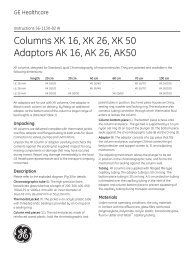
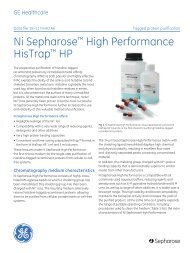
![[PDF] Sample preparation for analysis of protein, peptides and ...](https://img.yumpu.com/21549715/1/190x257/pdf-sample-preparation-for-analysis-of-protein-peptides-and-.jpg?quality=85)
![[PDF] Data File: rProtein A Sepharose Fast Flow](https://img.yumpu.com/21549316/1/190x253/pdf-data-file-rprotein-a-sepharose-fast-flow.jpg?quality=85)
![[PDF] MBP-tagged protein purification](https://img.yumpu.com/21548507/1/184x260/pdf-mbp-tagged-protein-purification.jpg?quality=85)
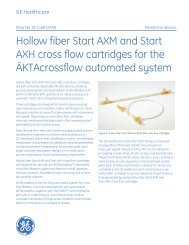
![[PDF] AKTA ready system Data file](https://img.yumpu.com/21540925/1/190x253/pdf-akta-ready-system-data-file.jpg?quality=85)
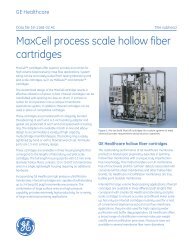
![[PDF] Data File - rProtein A/Protein G GraviTrap](https://img.yumpu.com/21539052/1/190x253/pdf-data-file-rprotein-a-protein-g-gravitrap.jpg?quality=85)
